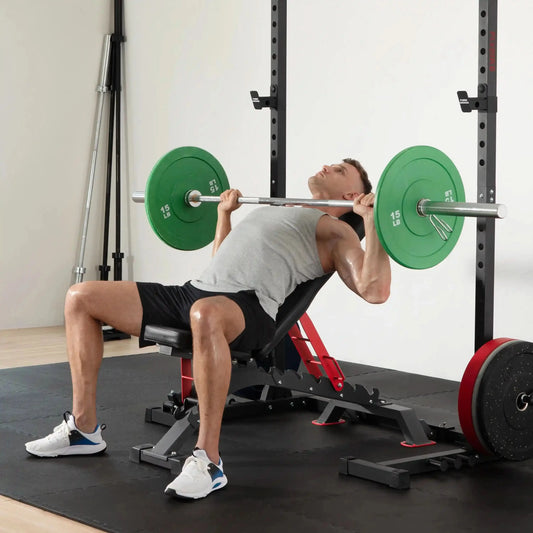They all got the same question: how much can I bench?
People want a shortcut to the strength level. They would like to know if they are a beginner, intermediate, or advanced lifter.
This guide will delve into the true meaning of "How much can you bench press?" We'll also show you how to safely measure your maximum bench press weight and provide evidence-based methods for building muscle.
How Much Can You Bench Really Mean?
The expression “How much can you bench?” sometimes truly means to the same person different things.
- The most weight you can complete one rep with in proper form.
- The working set weight you use for moderate reps (for example, sets of 5–10).
- How your bench press compares to your bodyweight and to others with similar experience.
All three matter. The 1-rep max represents the heaviest weight you can lift in one go. The working set weight shows your training capacity and readiness. This compares to bodyweight, so you have a fair comparison: lifting 250 lbs. gives you a much different result when your weight is 150 lbs or 220 lbs.
It’s actually much more informative to use a relative measure (bench press weight divided by bodyweight) and get a better idea how your strength compares. Using ratio or percentile as a part of your bench frame, you eliminate misleading raw numbers.
You must remember that adding 300 pounds on a person who already weighs 200 pounds is not the same as getting a body that weighs 300 pounds.
Bench Press Standards
If you want to see how your bench press compares, you can use benchmarks or “standards.” These are roughly based on bodyweight, sex, training age, and lift type. They give you targets and help identify if you’re a novice, intermediate, or advanced.
One large
study found that for young adults aged 18 to 35, the top 10% could bench about 1.95 times their bodyweight for men and 1.35 times for women.
The data came from over 800,000 lifts — more than 570,000 from men and about 238,000 from women.
The following are some rough ranges that you can set as targets for the raw barbell bench press:
For Men
- Novice: ~0.75 × bodyweight
- Intermediate: ~1.0 × bodyweight
- Advanced: ~1.5 × bodyweight
- Elite: ~2.0 × bodyweight (for young, well-trained)
For Women
- Novice: ~0.5 × bodyweight
- Intermediate: ~0.75 × bodyweight
- Advanced: ~1.25 × bodyweight
- Elite: ~1.5 × bodyweight
Key point: These are only benchmarks, not targets. They assume good form and safe execution. They also assume you are free of injury and reasonably trained.
How to Safely Test Your 1-rep Max Bench Press Strength
You don’t want to test your true max or anything too close to it without caution. Follow these directions to protect yourself and ensure the outcome is significant.
-
Warm Up Thoroughly. Start with 5–10 minutes of easy cardio, followed by dynamic mobility drills for shoulders, thoracic spine and chest.
-
Begin with Light Sets. Begin with the empty bar and put weight on gradually.
-
Use a Spotter. Especially when doing heavy weights.
-
Maintain Proper Form. Keep your form tight before adding maximal weight.
-
Use Controlled Tempo. Guide the bar down with control, pause, then drive up.
-
Rest Adequately. Rest 3-5 minutes between heavy singles.
-
Evaluate Results. Record what weight you achieved and how it felt.
-
Stop if You Feel Pain. Pain is a signal to stop.
What Factors Determine The Amount You Can Bench?
Many things affect how much you can bench press. When one understands them, they will be able to establish genuine goals and measure progress from that standpoint.
Bodyweight and Body Composition
It’s easier to lift heavier weights with your lean mass, rather than fat. Studies demonstrate a significant correlation between lean mass and 1-RM bench press strength for men and women.
Training Age and Experience
If you are a complete beginner, you will learn fast. When you become advanced, the gains stagnate, and you need subtler techniques.
Technique and Setup
Technique in bench press is important: grip width, bar-path, shoulder blade retraction, leg drive, and the arch. A tighter setup is less wasteful and makes you more efficient.
Mobility and Joint Health
There must be good shoulder, thoracic spine, and ankle mobility to support safe and effective lifts.
Neuromuscular Efficiency
How fast you can recruit muscle fibres via your nervous system is a huge contributing factor to maximal strength.
Sleep & Nutrition
If you are feeling tired continuously or you are not eating enough calories, then you won't be able to improve. You must ensure that you are having quality sleep and consuming enough protein.
Equipment & Environment
Proper bench, barbell, and a spotter plus safety pins (or rack) make good equipment, also a great help.
Mental Strength
Your mindset matters. Confidence, focus, and even having someone watch you can affect how you lift.
So, How to Improve Your Bench Press Number
To increase your bench press doesn’t just mean lifting heavier weights every week. It also means training more intelligently.
Here’s a simple plan that can help you improve:
Polish Technique
Spend time on your bench press setup.
Work on:
- Shoulder blade retraction and depression. You must be able to squeeze them together. And keep them tight while you lift.
- Foot placement and leg drive (feet flat, drive into the floor).
- Bar path (slightly diagonally, from chest up and back toward shoulders).
- Controlled eccentric (lower) and strong concentric (press) phases.
Use Progressive Overload
Strength builds when you gradually increase the work you do. Add weight, increase reps, or you can also increase volume over time. Track your data.
Train Frequency with Purpose
For most home lifters:
-
Session A: Heavy day — 3–5 sets of 1–3 reps at about 85–95% of your max.
-
Session B: Volume or technique day — 4–6 sets of 5–10 reps at around 65–75% of your max.
48–72 hours between sessions is recommended.
Accessory Movements
To get more results, you should add extra exercises to help your bench press:
- Do the close-grip benches to build your triceps.
- Must try incline benches for your upper chest and shoulders.
- Try using dumbbells to work on balance and control.
- Rowing, pull-ups, face-pulls (balance the pressing muscles with pulling)
- Board presses or floor presses (help range limitation and lockout strength)
Work the Lockout and Mid-Range
Most people get stuck around the middle of the lift. To fix that, try board presses, floor presses, or pin presses to build strength in that range.
Improve Leg Drive and Core Stability
Strength isn’t only in your chest and arms. A strong, stable core and leg drive contribute significantly to a successful bench. This makes planks, anti-rotation drills, and glute/hamstring work very useful.
Enough Rest & Nutrition
- Get 7-9 hours of sleep each night.
- Consume adequate protein (1.6–2.2 g per kg of bodyweight) and calories to support strength gains.
- Monitor your stress levels and avoid burnout.
Use Training Blocks
Break your training into focused blocks of 4–8 weeks. For example: 6 weeks of strength build, then 2 weeks of deload, then the next block. This allows you to plan progress and recovery.
Track Your Progress
Keep a workout log. Write the date, your weight, and what you lifted. Add your warm-ups and how you felt. Also, note how hard it felt, too. Check every few weeks and adjust.
Seek Variation and Smart Intensification
Once progress slows, introduce variations: paused bench, tempo changes, banded or chain loading, speed work (e.g., sets at 50–60% 1-RM moving the bar as fast as possible), which a study found improved max load by ~10% in 3 weeks for trained subjects.
Home Training Tips: Building Your Bench Strength Without a Gym
If you train at home, you can still build serious bench strength. Here are practical tips.
- Use a power rack or sturdy bench with safety pins. Safety first.
- A good barbell and adjustable plates offer versatility.
- Dumbbells support accessory work and fix imbalances.
- Bands or chains (if available) add accommodating resistance and speed training.
- Set up one heavy bench day and one volume/technique day per week.
- Keep sessions efficient: warm-up + main lifts + 2-3 accessory exercises.
- Use body-weight and upper-back work too: push-ups, rows, band pull-aparts improve balance and stability.
- Track your weights, reps, sets, and how you felt. Progress is built on data.
- Use compact equipment that fits your space and budget. Offer home-fitness bundles: bench + barbell + plates + guide.
- Include technique videos in your routine. Record your lifts sometimes to check your form and get better.
- Stay consistent because small gains each week add up over time.
- Also, focus on recovery and nutrition just like you would in a gym.
The Myth vs. Reality of the Bench Press
Let’s clear up some common misunderstandings regarding the bench press.
Myth: Daily Bench Press is a Must for Strength
Truth: Training often helps, but heavy lifting every day makes you tired and slows recovery. For most, two quality bench sessions a week suffice.
Myth: Going Very Wide Grip Always Means Heavier Lifts
Truth: A wider grip may reduce range, but it also increases shoulder stress. You might get heavier initially, but risk injury or limit long-term progress. Choose a grip width that fits your shoulder health and allows full range safely.
Myth: Dumbbell Bench Press Doesn’t Count
Truth: While a dumbbell bench isn’t the same as a barbell bench in mechanics and max 1-RM, it builds pressing strength, improves stabilisers, and balances left/right strength. It transfers well to barbell strength when used smartly.
Myth: Pain is Normal When Bench Pressing Heavy
Truth: Effort and muscular discomfort are acceptable. Sharp joint pain, clicking, or recurring soreness are not. Pain is a sign of a technical, mobility or load-management issue. Address it; don’t ignore it.
Myth: If You Train Hard Then You Should Be Bench Pressing Your Bodyweight in a Few Months
Truth: Beginners get stronger fast, but reaching a bodyweight bench press for men or about 0.75× for women takes time, consistency, and a solid plan. Progress slows down as you get stronger, so patience is key.
Conclusion
"How much can I bench press?" The measurement methods explained above should answer that question. If you work on your technique during training and recover fully, your bench press strength can steadily improve.
Even if you are exercising in your home gym then try to use a durable bench, a barbell, and plates. All you need to do is stick with your routine and always train consistently. And you must also track your workouts to keep your form.
FED Fitness’ bundles are designed for exactly this purpose: to get you strong, safe, and progressing without needing a big commercial gym.
Ready to lift more? Browse our
home bench bundles and start your first focused four-week cycle today.
Ready to lift more? Browse our home bench bundles and start your first focused four-week cycle today.
Common Inquiries (FAQs)
What’s a good bench press for my weight?
If you weigh 200 lbs and bench the same, that’s an intermediate level for men. For women, benching 110–120 lbs at 150 lbs bodyweight is about the same.
How often should I bench press?
For most, two bench sessions per week work well. One focused on heavy singles or low reps, the other focused on volume and technique. If recovery allows and you handle it well, a third light session might be added. Avoid going to failure too often.
Does dumbbell bench count the same as barbell bench?
Not exactly. While both train pressing muscles, the mechanics differ. Barbell bench allows higher absolute loads and different stabilization. The dumbbell bench helps with balance and stabilising muscles. Use both, but do not treat them as the same when comparing your one rep max.
When I bench press, my shoulder hurts. Why?
You must know that shoulder pain in the bench press usually comes from weak muscles or poor setup. Your grip might be wrong, or your shoulders and upper back might be too tight. Pain is a warning. Lower the weight and improve strength and mobility before lifting heavier.
How long will it take for me to get my bench press up?
If you are new, then you might see progress in a few weeks. But bigger gains take months of steady and smart training. Plan your workouts in four to eight-week blocks and track your progress. Also, make small changes when needed. A gain of five to ten percent in a few months is great progress.












